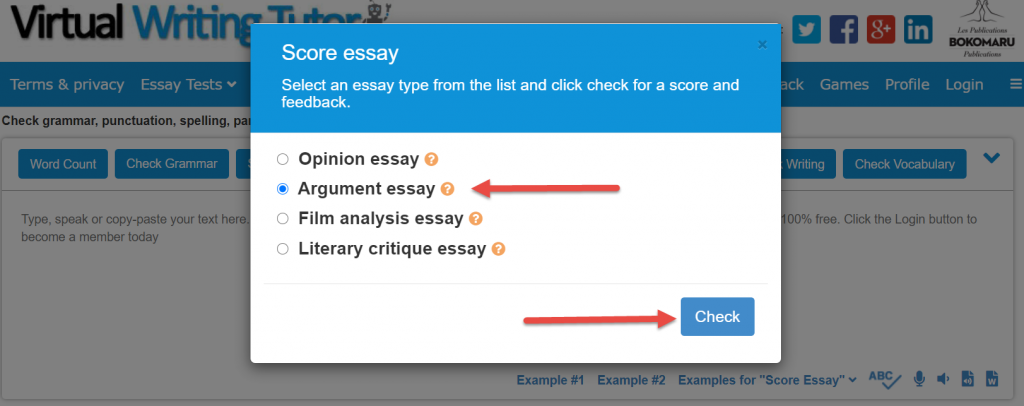Get your argument essay score in 2 seconds
Simply click on this link to the Virtual Writing Tutor grammar check website. Compose your argument essay and click “Score Essay,” select “Argument essay,” and click “Check. Use the score and feedback to help you revise and maximize your score when you submit your essay to your teacher.


The Argument Essay Structure
The structure of the argument essay is below. Master it and you will do well in academia.
Paragraph 1: introduction
- Opening: Begin the essay with a provocative, thought-provoking question. You could begin, for example, with “Did you know that…?”
- Context: Establish the importance of the topic. Use phrases like these: a vital factor in, the leading cause of, widely considered to be, set to become, undergoing a revolution, is responsible for.
- Thesis: Include a debatable thesis about one of these areas of controversy: abortion, climate change, animal rights, body image, feminism, immigration, internet censorship.
Paragraph 2: first supporting argument
- Topic sentence: Begin the paragraph with a topic sentence that summarizes the main idea of the paragraph and includes the first of the two topics in your thesis sentence.
- Argue: Refer to facts, statistics, logic, what is reasonable, what follows from the evidence, and conclusions one can draw.
- Evidence: Give evidence from your reading and research using these types of words: according to, to quote from, tells us that, shows us that, referring to, argues that, stated, wrote, argued, discussed, expressed the concern that, as written. Use these quotation marks: “…”
- Cite sources: Properly cite quoted text using the person’s family name in parentheses (Einstein).
- Support: Give examples to support your claims using words and phrases such as these: for example, for instance, suppose that, take the case of, that is, to be exact, to explain, to illustrate, to put another way, to show what I mean.
Paragraph 3: second supporting argument
- Topic sentence: Begin the paragraph with a topic sentence that summarizes the main idea of the paragraph and includes the second of the two topics in your thesis sentence.
- Argue: Refer to facts, statistics, logic, what is reasonable, what follows from the evidence, and conclusions you can draw.
- Evidence: Give evidence from your reading and research using these types of words: according to, to quote from, tells us that, shows us that, referring to, argues that, stated, wrote, argued, discussed, expressed the concern that, as written. Use these quotation marks: “…”
- Cite sources: Properly cite quoted text using the person’s family name in parentheses (Einstein).
- Support: Give examples to support your claims using words and phrases such as these: for example, for instance, suppose that, take the case of, that is, to be exact, to explain, to illustrate, to put another way, to show what I mean.
Paragraph 4: counterargument
- Topic sentence: Summarize an opposing view with words like these: some people claim, some believe, others believe, some people object to, try to refute, discount, reject, it is often argued that, the opposing side will claim.
- Concede: Show which parts of the counterargument have merit with words like these: concede that, granted, indeed, it is true that, while it is true that, naturally, to be sure, admittedly, one cannot deny that
- Refute: Refute the counterargument using words like these: nonetheless, nevertheless, regardless, whereas, although, and yet, in contrast, by contrast, despite, there is countervailing evidence, that said, however
Paragraph 5: conclusion
- Reformulation of the thesis: Restate the thesis in different words from the introduction.
- Build cohesion: Use expressions such as To sum up, To conclude, In closing, or For these reasons.
- Recommendation: Make a recommendation. Use one expression such as suggest, encourage, recommend, propose, what needs to be done.
- Prediction: Make a prediction. What will happen if the reader follows your recommendation? Use one expression such as should, ought to, will, or going to, predict, we can expect, I foresee, or it is likely that.
Works Cited section
- Heading: Identify this section of your essay with the heading, “Works Cited”
- List: Include at least 3 sources properly formatted, each on its own line.
Learn how you can get an interactive college-level course in persuasion for your students here.

